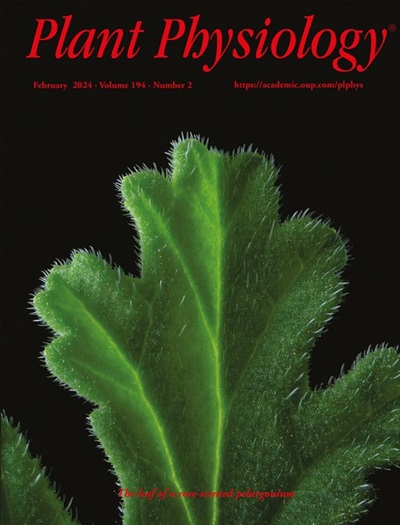The HAT1 transcription factor regulates photomorphogenesis and skotomorphogenesis via phytohormone levels.
IF 6.9
1区 生物学
Q1 PLANT SCIENCES
引用次数: 0
Abstract
Plants dynamically modulate their growth and development to acclimate to the fluctuating light environment via a complex phytohormone network. However, the dynamic molecular regulatory mechanisms underlying how plants regulate phytohormones during skotomorphogenesis and photomorphogenesis are largely unknown. Here, we identified a HD-ZIP II transcription factor, HOMEODOMAIN ARABIDOPSIS THALIANA1 (HAT1), as a key node that modulates the dose effects of brassinosteroids (BR) and auxin on hypocotyl growth during skotomorphogenesis and photomorphogenesis. Compared with the wild-type (Col-0), both HAT1 loss of function and its overexpression led to disrupted photomorphogenic and skotomorphogenic hypocotyl growth. HAT1 overexpression (HAT1OX) plants displayed longer hypocotyls in the light but shorter hypocotyls in darkness, whereas the triple mutant hat1hat2hat3 showed the opposite phenotype. Furthermore, we found that CONSTITUTIVE PHOTOMORPHOGENIC 1 (COP1) interacted with dephosphorylated HAT1 and facilitated the degradation of HAT1 by ubiquitination in darkness, while HAT1 was phosphorylated and stabilized by BRASSINOSTEROID INSENSITIVE2 (BIN2) in the light. Interestingly, we observed distinct dose-dependent effects of BR and auxin on hypocotyl elongation under varying light conditions and that HAT1 functioned as a key node in this process. The shorter hypocotyl of HAT1OX in darkness was due to the inhibition of BR biosynthetic gene BRASSINOSTEROID-6-OXIDASE2 (BR6OX2) expression to reduce BRs content, while brassinolide (BL) treatment alleviated this growth repression. In the light, HAT1 inhibited BR biosynthesis but enhanced auxin signaling by directly repressing IAA3/SHORT HYPOCOTYL 2 (SHY2) expression. Our findings uncover a dual function of HAT1 in regulating BR biosynthesis and auxin signaling that is crucial for ensuring proper skotomorphogenic and photomorphogenic growth.HAT1转录因子通过植物激素水平调控光形态发生和矮化形态发生。
植物通过复杂的植物激素网络动态调节其生长和发育,以适应波动的光照环境。然而,植物在脱落形态发生和光形态发生过程中如何调控植物激素的动态分子调控机制在很大程度上是未知的。在这里,我们发现了一个 HD-ZIP II 转录因子--HOMEODOMAIN ARABIDOPSIS THALIANA1(HAT1),它是在矮壮素(BR)和叶黄素对下胚轴生长的剂量效应进行调节的关键节点。与野生型(Col-0)相比,HAT1 的功能缺失和过表达都会导致光生和矮生下胚轴生长的紊乱。HAT1过表达(HAT1OX)植株在光照下表现出较长的下胚轴,但在黑暗中表现出较短的下胚轴,而三重突变体hat1hat2hat3则表现出相反的表型。此外,我们还发现,在黑暗条件下,CONSTITUTIVE PHOTOMORPHOGENIC 1(COP1)与去磷酸化的 HAT1 相互作用,并通过泛素化促进 HAT1 的降解,而在光照条件下,HAT1 被磷酸化,并被 BRASSINOSTEROID INSENSITIVE2(BIN2)稳定。有趣的是,我们观察到在不同的光照条件下,BR 和叶黄素对下胚轴伸长的影响具有不同的剂量依赖性,而 HAT1 在这一过程中起着关键节点的作用。在黑暗条件下,HAT1OX的下胚轴较短是由于抑制了BR生物合成基因BRASSINOSTEROID-6-OXIDASE2(BR6OX2)的表达,从而降低了BRs的含量,而黄铜内酯(BL)处理则缓解了这种生长抑制。在光照下,HAT1抑制BR的生物合成,但通过直接抑制IAA3/SHORT HYPOCOTYL 2(SHY2)的表达,增强了辅助素信号转导。我们的研究结果揭示了 HAT1 在调节 BR 生物合成和植物生长素信号转导方面的双重功能,这种功能对于确保正常的矮生和光生生长至关重要。
本文章由计算机程序翻译,如有差异,请以英文原文为准。
求助全文
约1分钟内获得全文
求助全文
来源期刊

Plant Physiology
生物-植物科学
CiteScore
12.20
自引率
5.40%
发文量
535
审稿时长
2.3 months
期刊介绍:
Plant Physiology® is a distinguished and highly respected journal with a rich history dating back to its establishment in 1926. It stands as a leading international publication in the field of plant biology, covering a comprehensive range of topics from the molecular and structural aspects of plant life to systems biology and ecophysiology. Recognized as the most highly cited journal in plant sciences, Plant Physiology® is a testament to its commitment to excellence and the dissemination of groundbreaking research.
As the official publication of the American Society of Plant Biologists, Plant Physiology® upholds rigorous peer-review standards, ensuring that the scientific community receives the highest quality research. The journal releases 12 issues annually, providing a steady stream of new findings and insights to its readership.
 求助内容:
求助内容: 应助结果提醒方式:
应助结果提醒方式:


